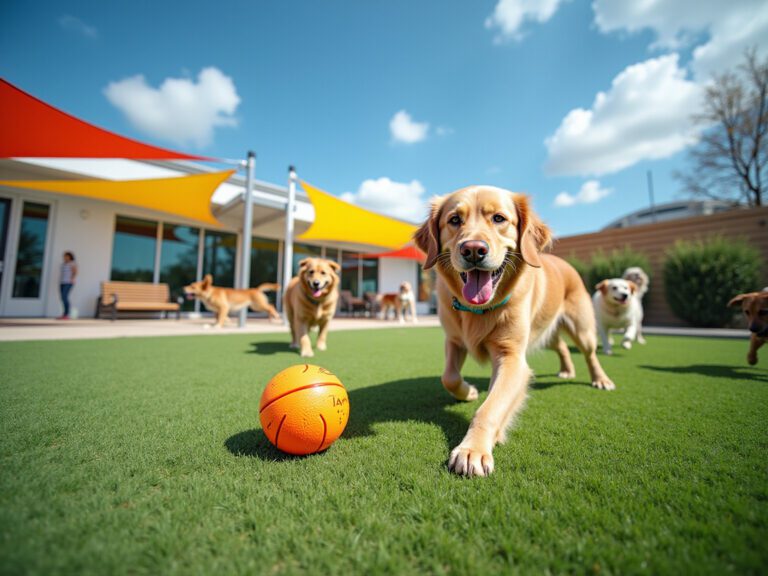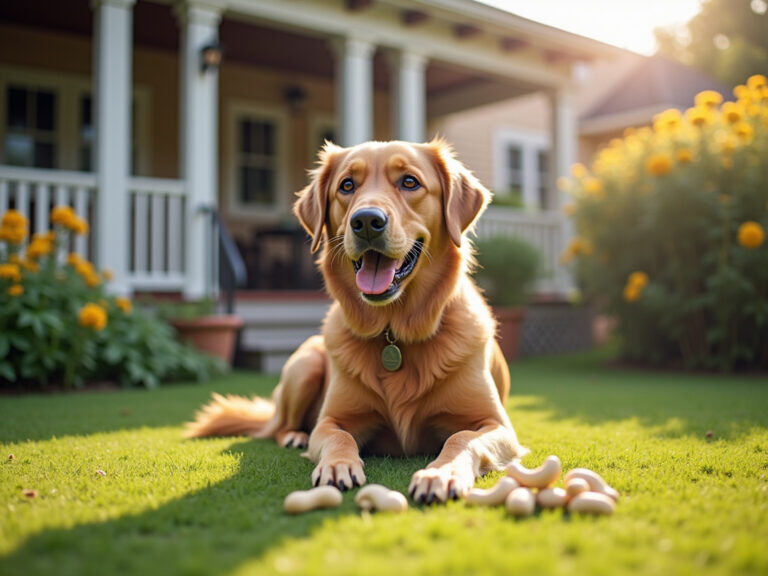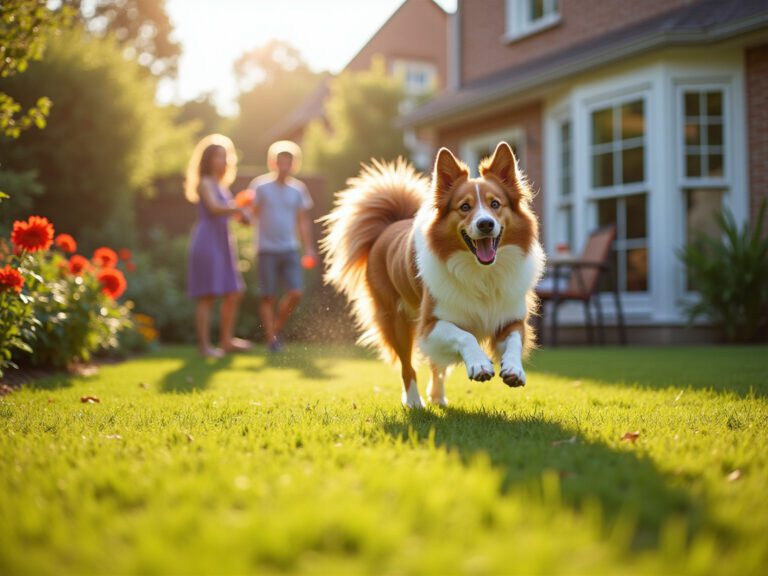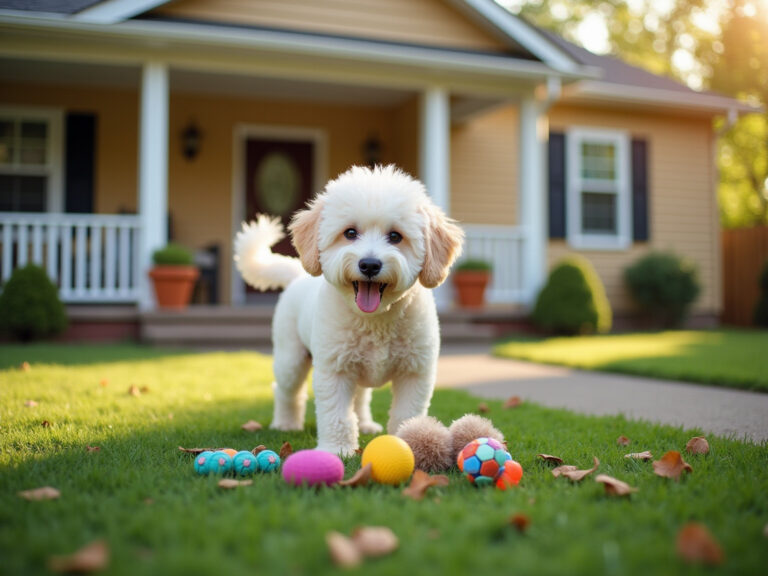Malamute vs Husky: Key Differences in Care and Compatibility
Overview
Understanding the differences in care and compatibility between Alaskan Malamutes and Siberian Huskies is crucial for nurturing your furry family members. These beautiful breeds have distinct temperaments, exercise needs, grooming requirements, and adaptability to family dynamics.
- Malamutes, known for their loyalty, can be more reserved and require firm training along with more grooming.
- On the other hand, Huskies are sociable and adaptable, often thriving in families with children.
Recognizing these differences is essential for creating a harmonious household where both pets and owners can flourish. By embracing these insights, you can ensure a loving and supportive environment for your beloved companions.
Introduction
In the world of canine companionship, few breeds spark as much debate and admiration as the Alaskan Malamute and the Siberian Husky. Both breeds, celebrated for their striking appearances and energetic dispositions, present unique temperaments and care requirements that every potential owner should thoughtfully consider. The Alaskan Malamute is known for its unwavering loyalty and strong family bonds, while the Siberian Husky enchants with its sociable and playful nature.
Understanding the nuances of each breed—from their training challenges to their lifestyle compatibility—is essential for anyone looking to welcome one of these remarkable dogs into their home. Imagine the joy of having a furry family member who fits seamlessly into your life! This article delves into the key differences and similarities between the two, providing valuable insights for prospective pet owners. With this knowledge, you can make an informed decision that ensures a nurturing environment for your new companion.
Compare Temperament: Alaskan Malamute vs. Siberian Husky
The Alaskan Malamute is truly a treasure, celebrated for its unwavering loyalty and deep affection for family members. They often form strong bonds with their owners, becoming cherished companions. While they tend to be somewhat reserved around strangers, displaying a cautious demeanor when encountering newcomers, this only adds to their unique charm.
In the discussion of malamute vs husky, the Siberian Husky is generally more sociable and friendly, eager to interact with both people and fellow dogs. Their playful and occasionally mischievous personality brings joy, though they can show a bit of stubbornness during training sessions.
Both breeds possess intelligence, yet Malamutes often exhibit a more self-reliant nature, frequently requiring a firmer approach to training. On the other hand, Huskies typically respond better to positive reinforcement techniques, making training a delightful experience. Understanding the differences in temperament between malamute vs husky is crucial for prospective caretakers, ensuring they can meet the social and training needs of their furry family members, especially in households with children or other pets.
It’s heartwarming to note that National Alaskan Malamute Day is celebrated every year on January 7, highlighting the breed’s cultural significance. As Jessica Reynolds wisely states, ‘If you are able to give them the time and attention they need, owning a Malamute can be an enjoyable and rewarding experience.’ Additionally, insights from the case study ‘Alaskan Malamute Temperament: Behavioral Insights’ shed light on the dog’s independent and occasionally stubborn character, which is vital for future owners to understand.
Lastly, knowing that Malamutes were welcomed into the AKC registry in the 1930s adds a rich historical context, deepening our appreciation for this remarkable breed. Embrace the journey of welcoming a malamute vs husky into your home, and know that with love and understanding, you’ll create a nurturing environment for your beloved pet.
Assess Care Needs: Nutrition, Exercise, and Grooming
When considering malamute vs husky, it’s clear that both the Alaskan Malamute and Siberian Husky thrive on high-quality diets rich in protein to fuel their active lifestyles. For instance, a 2-month-old male Siberian Husky can enjoy a nourishing combination of kibble and raw bone marrow, illustrating an appropriate diet for this breed.
Alaskan Malamutes typically require between 2 to 4.5 cups of dry food daily, depending on their size and activity level, while Siberian Huskies generally need about 1.5 to 3 cups. Exercise is crucial for both breeds, especially when considering malamute vs husky; Malamutes need at least 1 to 2 hours of vigorous activity each day, while Huskies often require even more—averaging about 2 hours—due to their higher energy levels.
Grooming needs also differ significantly: Malamutes have a thicker, denser coat that requires more frequent brushing, especially during shedding seasons. Huskies, while somewhat lower maintenance, still benefit from regular brushing to manage their shedding effectively.
It’s important to remember that while Malamutes are typically good with children and can make wonderful family pets, the malamute vs husky size difference might overwhelm small kids, so supervision during interactions is essential. Understanding these specific care requirements is key to ensuring that each breed thrives in a loving home.
Additionally, if you’re considering adding a furry family member to your life, researching similar breeds like Samoyeds and American Eskimos can help you find a dog that fits your lifestyle and preferences perfectly. Your journey towards nurturing a happy pet starts with informed choices!
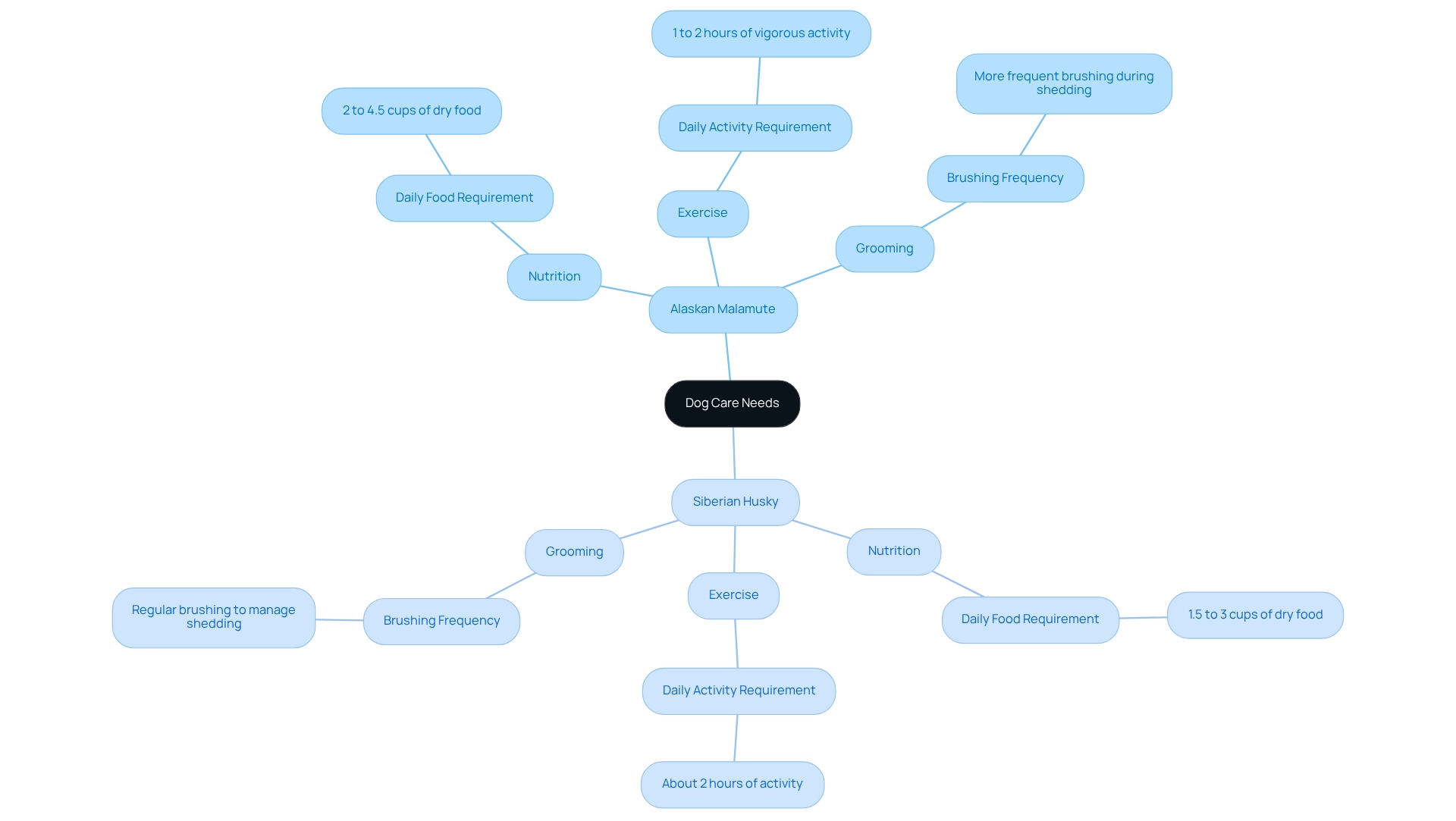
Evaluate Lifestyle Compatibility: Family Dynamics and Living Environment
The Alaskan Malamute is a wonderful companion for active households that can provide ample exercise and mental engagement. While they generally get along well with older children, their size and strength may present challenges in homes with very young kids. Malamutes thrive in spacious environments where they can roam and play freely, making them a great fit for families who can accommodate their needs.
On the other hand, Siberian Huskies are celebrated for their friendly nature and adaptability, making them an excellent choice for households with children and other pets. They can flourish in apartment settings as long as their exercise needs are met, but they truly shine in environments that offer plenty of space to run and explore. It’s important to note that Siberian Huskies shed a considerable amount of fur twice a year, which is a crucial consideration for families regarding grooming requirements.
Both breeds require sufficient socialization and training to ensure they integrate well into domestic life. However, Huskies tend to be more forgiving of inexperienced caretakers, thanks to their inherently sociable disposition. Many families report that Huskies often exhibit greater compatibility with children, as these dogs are known for their playful and gentle interactions. In contrast, Malamutes may show protective behaviors towards their owners, which can influence household dynamics, especially in multi-pet environments.
As highlighted by Allie Christoff, these breeds are categorized as working dogs, specifically within the sled dog group, emphasizing their need for activity and involvement. Understanding these nuances is essential for families considering malamute vs husky, as living conditions significantly impact their behavior and overall compatibility. Adventure Den, which caters to a diverse clientele, illustrates how different types of households engage with these breeds, further underscoring the importance of matching a dog’s traits with family dynamics.
Furthermore, Adventure Den offers tailored services that assist families in selecting the right breed and ensuring proper care. This makes it a valuable resource for pet caretakers, providing the support needed to create a nurturing environment for your furry family members.
Consider Training Challenges: Stubbornness and Intelligence
Training your Alaskan Malamute vs Husky can be a rewarding journey, but it does come with distinct challenges, primarily due to their independent nature and occasional stubbornness. These lovable dogs thrive on consistent and firm teaching methods, as harsh discipline may not yield the desired results. Positive reinforcement techniques shine in this context, creating an encouraging environment that fosters learning and good behavior. As noted, “Through consistent rewards for appropriate actions, positive reinforcement creates an environment that encourages learning and sets the foundation for well-behaved and obedient dogs.” Research supports these methods, highlighting their advantages for caregivers, making them a favored approach for nurturing your furry family members.
On the other hand, in the malamute vs husky discussion, Siberian Huskies are recognized for their intelligence, yet they too can exhibit stubbornness, which can test the patience of their trainers. Engaging activities and mental challenges are essential to keep their focus during practice sessions. When considering malamute vs husky, both breeds greatly benefit from early socialization and obedience instruction, but it’s important for caretakers to be ready for a long-term commitment to guidance, ensuring they can effectively handle their strong-willed natures.
Statistics indicate that 54.8% of dog owners view the recall command as the most crucial command for dogs, underscoring the importance of regular practice across all commands. This highlights the significance of addressing skill development challenges effectively. Real-world examples show that successful education of Siberian Huskies often incorporates fun and interactive methods, significantly enhancing their learning experience. By understanding the unique traits of these breeds and employing effective training strategies, you can cultivate well-behaved companions in a nurturing environment.
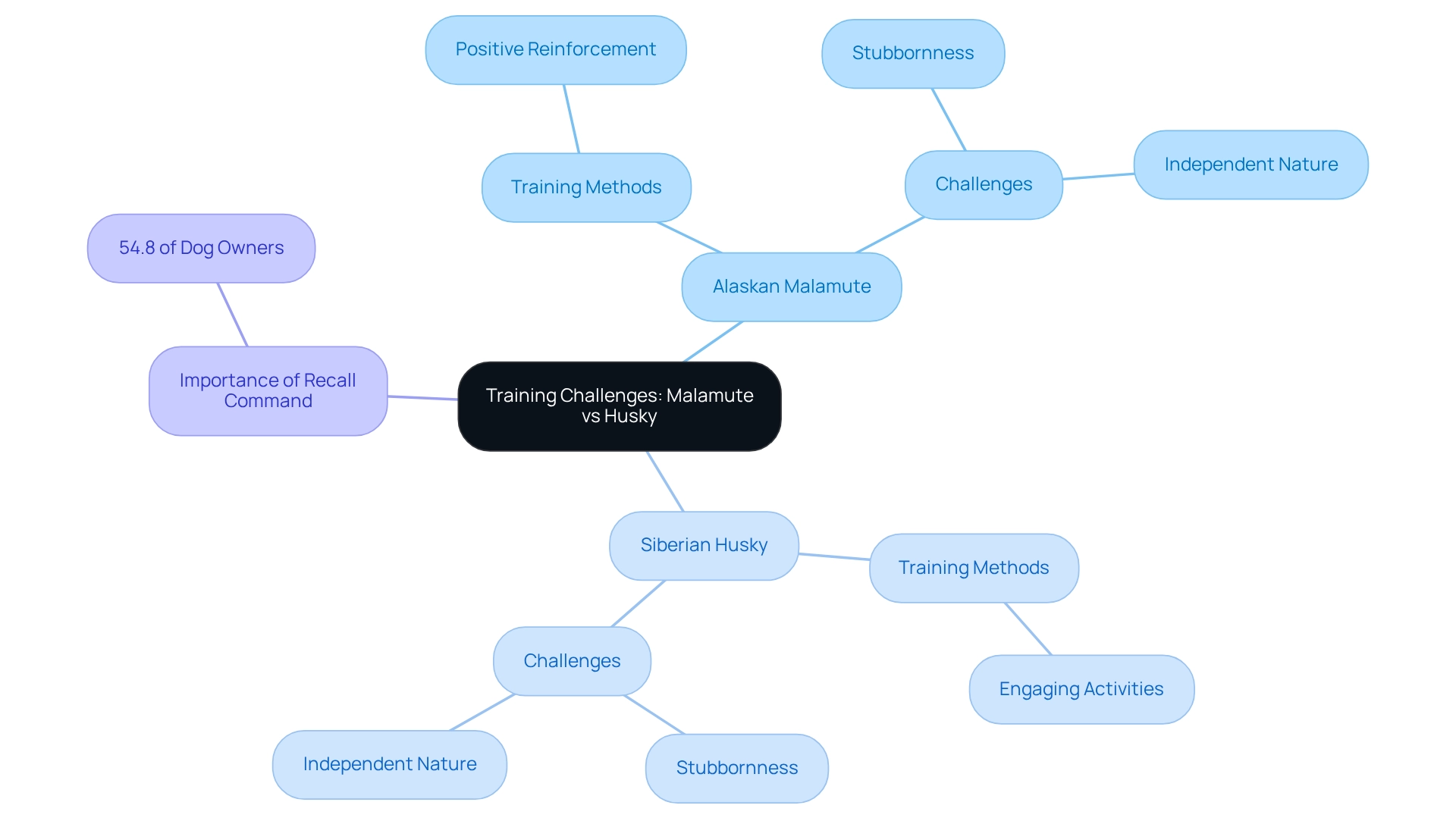
Conclusion
When considering the addition of a furry family member, it’s essential to understand the distinct temperaments, care needs, and lifestyle compatibility of the Alaskan Malamute and the Siberian Husky. The Malamute is celebrated for its unwavering loyalty and strong family bonds, thriving in active households that can provide ample exercise and mental stimulation. On the other hand, the sociable and playful nature of the Siberian Husky makes it a wonderful fit for families with children and other pets, flourishing in environments that allow for exploration and interaction.
Both breeds have specific care requirements that emphasize the importance of nutrition, exercise, and grooming. They both thrive on high-quality diets and require significant daily exercise, yet the Malamute’s thicker coat demands more frequent grooming compared to the somewhat lower maintenance needs of the Husky. Recognizing these unique care needs is vital for ensuring that each breed flourishes in a nurturing home environment.
Training challenges also play a crucial role in your decision-making process. Both breeds exhibit a blend of stubbornness and intelligence, which necessitates consistent and positive training methods. While Malamutes may benefit from a firmer approach, Huskies often respond best to engaging and interactive training techniques that keep their playful spirits alive.
Ultimately, choosing between an Alaskan Malamute and a Siberian Husky requires thoughtful consideration of each breed’s unique characteristics and how they align with your lifestyle and family dynamics. By embracing these nuances, you can make an informed decision that leads to a harmonious and fulfilling companionship with your new furry family member. Remember, at Adventure Den, we are here to support you every step of the way in creating a loving and nurturing environment for your pets.
Frequently Asked Questions
What are the key characteristics of the Alaskan Malamute?
The Alaskan Malamute is known for its unwavering loyalty and deep affection for family members. They form strong bonds with their owners and are cherished companions. Malamutes tend to be somewhat reserved around strangers, displaying a cautious demeanor when encountering newcomers.
How does the temperament of the Siberian Husky differ from that of the Alaskan Malamute?
The Siberian Husky is generally more sociable and friendly, eager to interact with both people and other dogs. They have a playful and occasionally mischievous personality but can be stubborn during training. In contrast, Malamutes are more self-reliant and may require a firmer training approach.
What training techniques work best for Malamutes and Huskies?
Malamutes often need a firmer approach to training due to their independent nature. Huskies typically respond better to positive reinforcement techniques, making training a more enjoyable experience for them.
Why is understanding the differences in temperament between Malamutes and Huskies important for prospective owners?
Understanding these differences is crucial for prospective caretakers to meet the social and training needs of their pets, especially in households with children or other animals.
When is National Alaskan Malamute Day celebrated, and why is it significant?
National Alaskan Malamute Day is celebrated every year on January 7, highlighting the cultural significance of the breed.
What insights do behavioral studies provide about the Alaskan Malamute?
Behavioral studies reveal that Alaskan Malamutes have an independent and occasionally stubborn character, which is important for future owners to understand.
When were Malamutes recognized by the American Kennel Club (AKC)?
Malamutes were welcomed into the AKC registry in the 1930s, adding a rich historical context to their appreciation as a breed.




